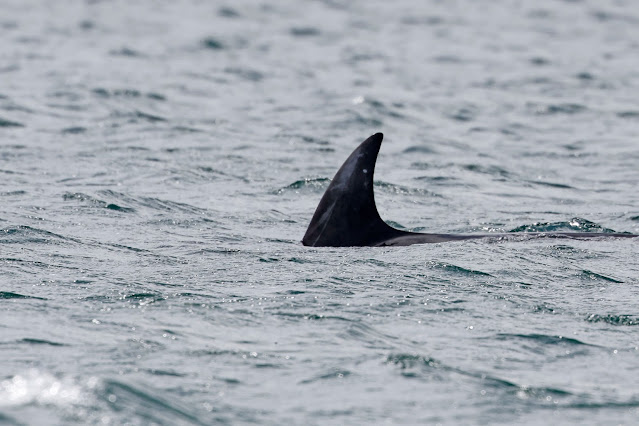I had booked this trip after an initial pelagic trip was cancelled. It wasn't comparable, but I hoped it would provide an opportunity to see a bird that has alluded me. We were on a four hour cruise that went around Falmouth Bay and then out into offshore waters, there was the chance of sea birds and Dolphins, but as I am fully aware nothing is guaranteed in nature.
Once out of Carrick Roads we came across the first birds of interest, a Mediterranean Gull, a bird that was causing quite a stir here, but one that is very familiar back home in Hampshire.
The primary search appeared to be for dolphins and Risso's in particular. We crossed the bay and then followed the east side of the Lizard Peninsula. As we passed Cadgewith we came across a group of three Risso's Dolphins, a distinctive dorsal fin breaking the water.
Risso’s dolphins have a blunt head with no
protruding beak, a crease runs from the blowhole on top of the head down
to the upper lip. Other notable features are the long sickle-shaped
pectoral fins, with the dorsal fin, also sickle-shaped, standing tall
from its central position on the back.
Risso’s dolphin is among the largest of the dolphin species, adults growing up to 3.8 m. They are mostly grey but are usually paler or white underneath which may help to conceal them from predators. As they get older, males in particular will gain an increasing number of scars from battles with other males to establish dominance within a group, giving them access to the females for mating. The scars are made by their teeth as they ‘rake’ each other across the body during the fights, causing a series of long thin slices that, once healed over, are white.
Risso’s dolphins are a deep-water species, preferring the
offshore areas near the
continental shelf. They are also sometimes seen close to the coast,
particularly where
land quickly gives way to deep water. It is not known whether this is part of a
seasonal movement or migration, but may be linked to prey movements. Such as
squid and cuttlefish.
Leaving the dolphins we headed out to offshore water which was a little choppy. Ahead there were good number of birds gathering over the water, as we approached I could see plenty of Manx Shearwater and several immature Gannets. The hope was the one bird I wanted to see was with them.
There was clearly an upwelling of bait fish, pilchards and mackerel and the birds could be seen diving into the water.
An immature Gannet, looks like a second year bird coming towards us.
Rafts of Manx Shearwater gathered on the water.
Then the raft flushed as we came just too close.
Some great views of the Manx Shearwaters.
One of a handful of adult Gannets passing over the boat.
Immature Gannets gaining height and twisting and diving into the bait ball.
The Gannets leaving the water to try once again.
Other birds seen were Kittiwake, Razorbill and a lone Curlew. Not unfortunately the hoped for Storm Petrel, so the wait goes on. I will leave the post with a couple of Manx Shearwater, a bird it is always good to get close to.
























No comments:
Post a Comment